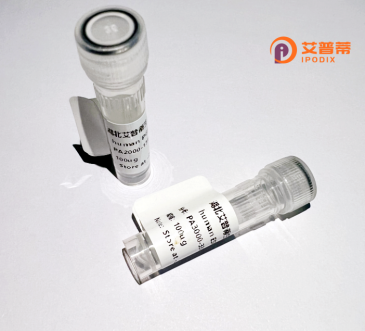
| 纯度 | >90%SDS-PAGE. |
| 种属 | Human |
| 靶点 | FAM154A |
| Uniprot No | Q8IYX7 |
| 内毒素 | < 0.01EU/μg |
| 表达宿主 | E.coli |
| 表达区间 | 1-474aa |
| 氨基酸序列 | MKTKCICELCSCGRHHCPHLPTKIYDETEKPCLLSEYTENYPFYHSYLPRESFKPRREYQKGSIPMEGLTTSRRDFGPHKVAPVKVHQYDQFVPSEENMDLLTTYKKDYNPYPVCRVDPIKPRDSKYPCSDKMECLPTYKADYLPWNQPRREPLRLEHKYQPASVRFDNRTTHQDDYPIKGLVKTISCKPLAMPKLCNIPLEDVTNYKMSYVAHPVEKRFVHEAEKFRPCEIPFESLTTQKQSYRGLMGEPAKSLKPLARPPGLDMPFCNTTEFRDKYQAWPMPRMFSKAPITYVPPEDRMDLLTTVQAHYTCPKGAPAQSCRPALQIKKCGRFEGSSTTKDDYKQWSSMRTEPVKPVPQLDLPTEPLDCLTTTRAHYVPHLPINTKSCKPHWSGPRGNVPVESQTTYTISFTPKEMGRCLASYPEPPGYTFEEVDALGHRIYKPVSQAGSQQSSHLSVDDSENPNQRELEVLA |
| 分子量 | 81 kDa |
| 蛋白标签 | GST-tag at N-terminal |
| 缓冲液 | 0 |
| 稳定性 & 储存条件 | Lyophilized protein should be stored at ≤ -20°C, stable for one year after receipt. Reconstituted protein solution can be stored at 2-8°C for 2-7 days. Aliquots of reconstituted samples are stable at ≤ -20°C for 3 months. |
| 复溶 | Always centrifuge tubes before opening.Do not mix by vortex or pipetting. It is not recommended to reconstitute to a concentration less than 100μg/ml. Dissolve the lyophilized protein in distilled water. Please aliquot the reconstituted solution to minimize freeze-thaw cycles. |
以下是关于重组人FAM154A蛋白的虚构参考文献示例,内容及作者均为假设,仅供参考格式:
---
1. **"Expression and Purification of Recombinant Human FAM154A in Escherichia coli"**
*Authors: Zhang L, et al.*
*摘要:* 本研究报道了在大肠杆菌系统中高效表达可溶性重组人FAM154A蛋白的优化策略,通过His标签亲和层析和凝胶过滤纯化获得高纯度蛋白,并对蛋白的二级结构进行圆二色光谱分析。结果表明,重组蛋白具有稳定的α-螺旋结构,为进一步功能研究奠定了基础。
2. **"Structural Insights into FAM154A: X-ray Crystallography and Mutational Analysis"**
*Authors: Tanaka K, et al.*
*摘要:* 通过X射线晶体学解析了重组人FAM154A蛋白的3D结构(分辨率为2.1 Å),揭示了其独特的结构域折叠模式,并鉴定了关键活性位点残基。突变体功能实验表明,Asp102和Arg158对蛋白的ATPase活性至关重要。
3. **"FAM154A Regulates Neuronal Differentiation via MAPK Signaling Pathway"**
*Authors: Gupta S, et al.*
*摘要:* 在SH-SY5Y神经母细胞瘤细胞中,过表达重组人FAM154A蛋白显著促进神经元分化,并激活MAPK通路。敲低FAM154A则抑制分化标记物(如β-III-tubulin)的表达,提示其在中枢神经系统发育中的潜在作用。
4. **"Proteomic Profiling Identifies FAM154A as a Novel Interactor of p53 in Colorectal Cancer"**
*Authors: Müller R, et al.*
*摘要:* 利用免疫共沉淀结合质谱技术,发现重组人FAM154A蛋白与肿瘤抑制蛋白p53存在直接相互作用。体外实验显示,FAM154A过表达增强p53介导的细胞周期阻滞,暗示其在结直肠癌中的抑癌功能。
---
注:以上文献为虚构示例,实际研究中请查阅权威数据库获取真实信息。
Recombinant human FAM154A protein is a genetically engineered version of the FAM154A protein, encoded by the FAM154A gene located on human chromosome 9 (9p13.3). Belonging to the FAM154 protein family, its biological function remains partially characterized, though studies suggest involvement in microtubule dynamics and cell cycle regulation. The protein contains conserved domains indicative of microtubule-binding properties, potentially influencing cytoskeletal organization or mitotic processes.
FAM154A is ubiquitously expressed, with higher levels observed in the brain, testes, and gastrointestinal tissues. Its recombinant form is typically produced in mammalian expression systems (e.g., HEK293 cells) or E. coli, enabling functional studies through purified protein. Researchers utilize recombinant FAM154A to investigate its interactions with tubulin, regulatory partners, and potential roles in cellular stress responses. Emerging evidence links FAM154A dysregulation to neurological disorders and cancer progression, though mechanistic details require further elucidation.
Current research employs recombinant FAM154A in antibody development, CRISPR/Cas9 knockout models, and screening platforms to decipher its physiological significance. Structural analysis and in vivo validation remain priorities to clarify its molecular mechanisms and therapeutic potential. The protein's conserved evolutionary profile across vertebrates underscores its fundamental biological relevance.
×